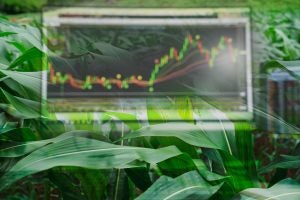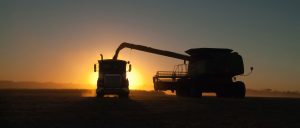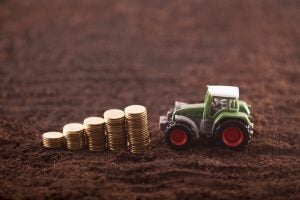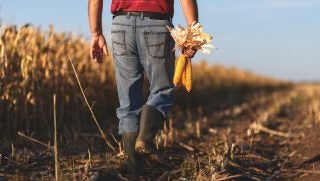It may have felt something like a “Hard Candy Christmas,” as Dolly Parton might sing, for U.S. farmers this year, especially as they await more information about commodity prices and input costs for 2024. Meanwhile, the word has been out for quite a while that market prices for major crops like corn and soybeans are expected to fall this year from historic highs. Even so, many input costs are on the rise, and interest rates remain high, particularly for new equipment.
Earlier in November, President Joe Biden signed a funding extension of the 2018 Farm Bill for yet another year, with lawmakers looking to craft new and updated legislation that reflects present numbers. With the existing legislation based on pre-COVID pricing and inputs, farmers across the country have entered 2024 with a lot of questions.
Shane Litz, vice-president and commercial loan officer at Terre Haute Savings Bank, which serves the greater Wabash Valley in west-central Indiana, said the present reminds him of the past.
“We saw this back in 2008, as well as back in 2012 after the drought,” the ag lender of 20-plus years said. “I think it’s pretty cyclical.”

With market disruptions as seismic as COVID-19, the war in Ukraine, and relatively stark changes in the prime interest rate at play, it’s no wonder that what goes up must come down.
Coming up soon
Late this past year, the U.S. Department of Agriculture released the U.S.-focused portion of its Agricultural Projections to 2033 report, with a complete report due out in February. Some of the numbers projected are reminiscent of a hayride through a bumpy field.
According to the U.S. corn long-term projections, total planted acres for that crop in the U.S. will jump from 88.6 million acres in the 2022/2023 season to 94.9 million acres in 2023/2024. Bushels harvested per acre are expected to stay the same, but what’s noticeable is the projected farm price dropping from $6.54 per bushel to $4.95, with $4.50 projected for 2024, and $4.30 the year afterward. The U.S. report estimates that net returns could fall from $617 per acre to $386, $372, and $350 in coming years.
Meanwhile, the net return for oats per acre is expected to drop from $100 to $50 in the same period, but sorghum could spike from $34 to $91.

Input costs and yet more whackery within the global supply chain are all at play, as the U.S. Macroeconomic Assumptions through 2033 point out the difference in interest rates on all things financing. Whereas in 2022, the U.S. Federal Reserve Prime Interest rate was 4.85 percent, in 2023 it jumped to 8.19 percent and is expected to fall only to 7.70 percent in 2024. Crude oil prices per barrel averaged $92.80 in 2022 versus $76.30 in 2023 and are expected to go back to $80.50 in 2024 and then perhaps up to $101 by 2029.
Fertilizer and other direct input costs are expected to fall slightly from their spike in 2022, but as Purdue University agriculture economist Michael Langemeier wrote in October, those prices won’t fall below the historical averages. So breakeven costs per acre for some crops may fall this year, but farmers could still wind up netting less due to falling prices and an increased cost of financing.
What’s in store down the road?
With the potential of declining commodity prices and increased financing and equipment costs potentially overtaking the drop in fertilizer, smaller ag producers are more likely to be impacted than larger groups, meaning farm management is more important than ever.
Litz from Terre Haute Savings Bank said the good news is that as a whole, producers have had two really good, record-setting years in terms of profitability, and that should help. The real squeeze will, as usual, be felt by smaller producers — those with less than 400 acres. The cost of new, and even used equipment, is getting to the point that smaller producers just can’t justify it.
With new equipment financing at the bank running between 7.5 percent and 8 percent, the cost of even a used combine may be out of reach, as those are running between $150,000 and $200,000. To that extent, the impact of inflation isn’t just being felt at the seed dealership, but with all things tool and vehicle related. Back in 2019, the prime lending rate was about 4 percent, he said, noting how big a difference that makes to producers with smaller numbers of acres and thus lower gross returns.

This is leading more and more landowners to shift from full-time production and into cash-renting positions, with some even accepting contract pay from the larger farm corporations to help farm their own ground, he said. For many farmers in this category, off-farm employment is already a given, and it just makes more sense to lease out their land for cash and accept the part-time pay from the tenant company to help do what they’ve always done.
In the big picture though, Litz said this is the fourth time he’s seen this type of phenomenon in the last 20 years, and the good news is, people are still farming onward. If producers are looking for any indication of what’s yet to come, they would do well to remember the lessons learned the past in terms of cycles.
Brian Boyce is an award-winning writer living on a farm in west-central Indiana. You can see more of his work at the Boyce Group homepage.



